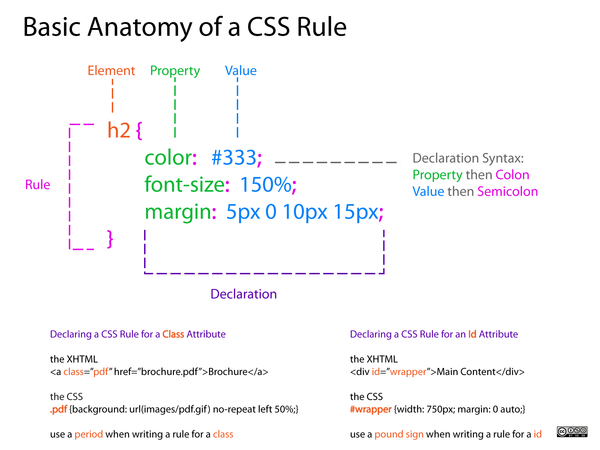Difference between revisions of "Courses/Design & Technique-Essential Web Design/03"
(→id) |
|||
| Line 119: | Line 119: | ||
'''Classes''' can be used INFINITE TIMES in a file. They are used to '''group''' tags. | '''Classes''' can be used INFINITE TIMES in a file. They are used to '''group''' tags. | ||
The symbol for class is: <code> | The symbol for class is: <code>.</code> | ||
<source lang="html4strict"> | <source lang="html4strict"> | ||
< | <div class="text">Aa</p> | ||
< | <span class="text">Bbbbb</p> | ||
<p class="text"> | <p class="text">Ccccccccccc</p> | ||
</source> | </source> | ||
==css class selector(for a group of elements)== | |||
if I write the rule: | |||
<source lang="css"> | |||
.text { background: blue; | |||
font-size:30pt; | |||
color: white; } | |||
</source> | |||
no matter what elements do have the class text, they will all be encompassed by this rule. | |||
==styling links== | ==styling links== | ||
| Line 137: | Line 145: | ||
a:hover - a link when the user mouses over it | a:hover - a link when the user mouses over it | ||
a:active - a link the moment it is clicked | a:active - a link the moment it is clicked | ||
For each of them, normally a rule is written. | |||
| Line 147: | Line 157: | ||
https://developer.mozilla.org/en-US/docs/Web/CSS/display | https://developer.mozilla.org/en-US/docs/Web/CSS/display | ||
==position property== | ==position property== | ||
| Line 157: | Line 163: | ||
* fixed | * fixed | ||
https://developer.mozilla.org/en-US/docs/Web/CSS/position | https://developer.mozilla.org/en-US/docs/Web/CSS/position | ||
| Line 167: | Line 170: | ||
* Lynda.com CSS-Selectors (Part 1) http://www.lynda.com/CSS-tutorials/CSS-Selectors/192036-2.html?org=hr.nl | * Lynda.com CSS-Selectors (Part 1) http://www.lynda.com/CSS-tutorials/CSS-Selectors/192036-2.html?org=hr.nl | ||
* Lynda.com CSS Gradients (Part2,3) http://www.lynda.com/CSS-tutorials/Exploring-linear-syntax/115467/122823-4.html | * Lynda.com CSS Gradients (Part2,3) http://www.lynda.com/CSS-tutorials/Exploring-linear-syntax/115467/122823-4.html | ||
* http://www.w3.org/Style/Examples/007/center.en.html | |||
==Next week== | ==Next week== | ||
Will be dedicated to CSS for typography; And web-fonts; | Will be dedicated to CSS for typography; And web-fonts; | ||
Revision as of 18:03, 21 September 2015
Styling your page with CSS
CSS - Cascading Style Sheets
HTML is not meant to style (inline syling: style="color:...") is old fashion and discouraged.
CSS is the preferred to way to style.
- HTML tell the browser what content it should display
- CSS tells the browser how to display that content.
css in your html page
<style> CCS code goes inside the style tags </style>- inside the head of the html page.
<!DOCTYPE html>
<html>
<head>
<style>
<!-- you css style-sheet will go in here -->
body{
background: #FF19DC;
color: black;
font-family: mono;
}
</style>
</head>
</html>
<body></body>
</html>
anatomy of a css rule
Each CSS style sheet is made of several rules.
Each rule follows the syntax:
Example of a CSS rule
- element (what element(s) is being styled)
- property (what property of that element is being styled): value pair (how is it being styled)
div {
background: blue;
color: white;
width: 500px;
height: 250px;
font-size:30pt;
}
Here we are styling all the div elements in the html page.
css properties
CSS Property reference https://developer.mozilla.org/en-US/docs/Web/CSS/Reference
Some properties.
- color, background-color, width, height
- border, box-shadow, list-style
- margin, padding
- transform, gradient, border-radius
Use some of these properties to style your page.
a separate CSS file
The CSS for a HTML page (or several pages) can stored outside that page, in css file.
To do that we need link the HTML file to the CSS file, using the tag link inside the html head. <link href="style.css" rel="stylesheet" />
<!DOCTYPE html>
<html>
<head>
<link href="style.css" rel="stylesheet" />
</head>
<body>
....
id and class attributes
Two of the most used attributes in HTML is id and class.
They are important to distinguish and group different elements. And become particularly important in CSS styling.
Note:
id
Ids cannot repeat in the same file.
Ids are used to distinguish tags
The symbol for id is: #
<p id="special">I am special paragraph</p>
<p>Just another paragraph.</p>
<p>More of the same.</p>
Note: Ids can server as a anchor (link) point within each page.
css id selector(for a specific element)
# is the symbol used to indicate an id.
if I write the rule:
p#special { transform: matrix(1.0, 2.0, 3.0, 4.0, 5.0, 6.0);}
Only the paragraph with id="special" will be effected by the rule above.
class
Classes can be used INFINITE TIMES in a file. They are used to group tags.
The symbol for class is: .
<div class="text">Aa</p>
<span class="text">Bbbbb</p>
<p class="text">Ccccccccccc</p>
css class selector(for a group of elements)
if I write the rule:
.text { background: blue;
font-size:30pt;
color: white; }
no matter what elements do have the class text, they will all be encompassed by this rule.
styling links
css uses a pseudo-class for the different states of a link
a:visited - a link the user has visited
a:hover - a link when the user mouses over it
a:active - a link the moment it is clicked
For each of them, normally a rule is written.
display
- display: none;
- display: inline;
- display: block;
- display: inline-block;
https://developer.mozilla.org/en-US/docs/Web/CSS/display
position property
- relative
- absolute
- fixed
https://developer.mozilla.org/en-US/docs/Web/CSS/position
Online Resources
- CSS Property reference https://developer.mozilla.org/en-US/docs/Web/CSS/Reference
- Lynda.com CSS-Selectors (Part 1) http://www.lynda.com/CSS-tutorials/CSS-Selectors/192036-2.html?org=hr.nl
- Lynda.com CSS Gradients (Part2,3) http://www.lynda.com/CSS-tutorials/Exploring-linear-syntax/115467/122823-4.html
- http://www.w3.org/Style/Examples/007/center.en.html
Next week
Will be dedicated to CSS for typography; And web-fonts;
